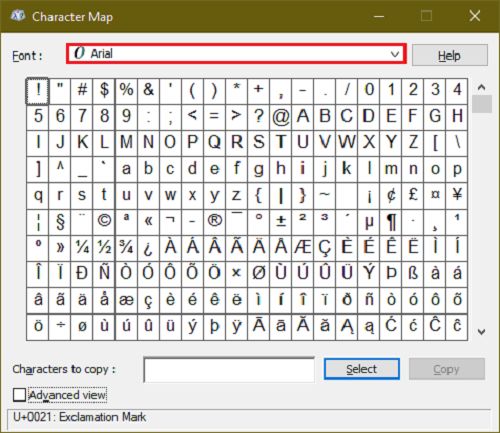Defining Special Characters
Special characters are a unique category of symbols and characters that expand the possibilities of written and digital communication. These characters go beyond the standard alphabet (A to Z), numerals (0 to 9), and common punctuation marks (like periods and commas) that we encounter in everyday writing.
In essence, special characters are the diverse set of symbols and icons that provide additional layers of expression, functionality, and meaning to our text-based communication. They can take the form of punctuation marks, mathematical symbols, currency signs, emoticons, special icons, and more. These characters serve various purposes, such as conveying emotions, emphasizing text, facilitating mathematical operations, and adding visual elements to written content.
In the digital age, special characters have become an integral part of our online conversations, enabling us to express ourselves more vividly and creatively. They play a crucial role in enriching our text with nuance, tone, and context, making our communication more engaging and expressive. Furthermore, special characters are essential in cybersecurity, where they enhance the strength and complexity of passwords, protecting our digital identities and sensitive information from potential threats.
How to type special characters
| Character | Description | Use | Keystroke |
| ~ | Tilde | Accent mark commonly used in Spanish | Shift + ` |
| } | Close brace | Closes groups of statements or blocks of code in various programming languages | Shift + ] |
| | | Vertical bar, pipe | Delimiter in text files; redirects a command’s output to the input of another in a command line interface (CLI); represents an OR boolean operator (double pipe) | Shift + \ |
| { | Open brace | Opens groups of statements or blocks of code in various programming languages | Shift + [ |
| ` | Grave accent | Accent mark commonly used in French | ` |
| _ | Underscore | Alternative to space key when spaces are not allowed | Shift + – |
| ^ | Circumflex, caret | Expresses exponents in mathematics; shorthand for CTRL key on PCs | Shift + 6 |
| ] | Close bracket | Ends section of missing details in quoted text; ends string validation in programming languages; ends mathematical notation for intervals | ] |
| \ | Backslash | Separates locations in a file or network path | \ |
| [ | Open bracket | Begins section of missing details in quoted text; begins string validation in programming languages | [ |
| @ | Ampersat | Connects usernames to domain names in email addresses; expresses rates in accounting and invoicing; precedes usernames/handles on social media platforms and chat rooms | Shift + 2 |
| ? | Question mark | Indicates the end of an interrogative sentence | Shift + / |
| = | Equal sign | Mathematical equations | = |
| ; | Semicolon | Joins two related sentences in written text; finishes an instruction in programming languages; separates long list items in written text | ; |
| : | Colon | Separates the protocol from a web address in a URL; identifies a range in a spreadsheet formula; precedes a list of items in written text | Shift + ; |
| / | Forward slash | Mathematical division; separates month, day, and year of a date; signifies non-executable statements in programming languages; closes tags in HTML and XML; delimits expressions; separates locations in a file or network path; writes URLs and network addresses | / |
| . | Period | Indicates the end of a declarative or imperative sentence; separates a file name from the file extension; separates sections of a URL | . |
| , | Comma | Separates items in a list, joins independent clauses or sentences with a conjunction; separates digits in large numbers; separates values or elements in a computer program | , |
| + | Plus sign | Mathematical additions | Shift + = |
| * | Asterisk | Mathematical multiplication; indicates footnotes | Shift + 8 |
| ) | Close parenthesis | Ends parenthetical text | Shift + 0 |
| ( | Open parenthesis | Begins parenthetical text | Shift + 9 |
| ‘ | Single quotation mark, apostrophe | Contains commands or literal strings; indicates a quotation within a quotation; expresses a contraction or possessive noun in written context | ‘ |
| < | Mathematical division; separates month, day, and year of a date; signifies non-executable statements in programming languages; closes tags in HTML and XML; delimits expressions; separates locations in a file or network path; writes URLs and network addresses | Expresses the relationship between two values in which the one on the right is greater than the one on the left | Shift + , |
| > | Close angle bracket, greater than symbol | Expresses the relationship between two values in which the one on the left is greater than the one on the right | Shift + . |
| & | Ampersand | Symbolizes “and” in English text; combines values in spreadsheet formulas | Shift + 7 |
| % | Percent sign | Expresses value in percentages | Shift + 5 |
| $ | Dollar sign | Expresses value in currency | Shift + 4 |
| # | Octothorpe | Number sign; expresses non-executable statement in programming; triggers hashtags on social media | Shift + 3 |
| “ | Double quotation mark | Indicates a verbatim transcription of something that has been written or spoken; identifies text or data that is not part of a programming command or HTML tag | Shift + ‘ |
| ! | Exclamation point | Indicates the end of an exclamatory sentence or phrase; expresses logical negation in programming languages; notes factorial operation in mathematics | Shift + 1 |
| – | Hyphen, dash | Mathematical subtractions; creates en dashes or em dashes in written text | – |
Special Characters in Passwords
When crafting a secure password, it’s essential to include special characters to enhance its strength and resilience against potential cyber threats. Special characters refer to symbols such as !, @, #, $, and %, among others. Incorporating these characters into your password not only increases its complexity but also makes it more challenging for unauthorized individuals or automated programs to guess or crack. A strong password is a key component of robust cybersecurity practices, and the inclusion of special characters adds an extra layer of defense against brute-force attacks. Remember to create a unique combination of letters, numbers, and special characters to fortify your password and safeguard your sensitive information online.
The Crucial Role of Special Characters
Special characters play a crucial role in bolstering security, especially in password creation. By introducing symbols like !, @, or #, passwords become more resistant to hacking attempts. These characters increase the possible combinations, making it significantly harder for unauthorized access. In essence, they enhance the complexity of passwords, fortifying digital defenses against brute-force attacks and ensuring a higher level of data protection. Incorporating special characters is an essential practice in promoting robust cybersecurity and safeguarding sensitive information in an increasingly interconnected and digital landscape.
Creating Strong Passwords with Special Characters
Crafting a secure password involves using special characters effectively. Here are some tips for creating strong passwords:
Mix Character Types: Combine uppercase letters, lowercase letters, numbers, and special characters in your password.
Avoid Common Words: Refrain from using easily guessable words, phrases, or patterns, even with special characters.
Longer Is Stronger: Longer passwords are generally stronger. Aim for a minimum of 12 characters.
Randomness Matters: Avoid using predictable sequences or easily guessable patterns, such as “12345” or “password.”
Password Managers: Consider using a password manager to generate and store complex passwords securely.
Why Special Characters Matter
Special characters play several vital roles in digital communication:
Enhancing Textual Expressiveness: Special characters allow us to convey emotions, tone, and emphasis in our text. Emoticons, for instance, help us express happiness, sadness, or excitement in a simple and relatable way.
Ensuring Secure Passwords: In the realm of cybersecurity, special characters are indispensable for creating strong and secure passwords. They add complexity and make passwords more resilient to hacking attempts.
Special Characters in Programming: Programmers and coders often use special characters for various purposes, such as defining variables or specifying operations.
Frequently Asked Questions:
- What are special characters, and why are they important in digital communication?
Special characters are symbols and icons that go beyond standard letters and numbers, adding depth and expressiveness to text. They are crucial for conveying emotions, emphasizing text, and enhancing the overall meaning of digital content. - How can I use special characters effectively in my online communication?
Using special characters effectively involves understanding their meanings and context. Emoticons, for instance, can convey emotions, while symbols like arrows or stars can add visual emphasis. Experiment with different characters to find the right fit for your message. - What role do special characters play in creating strong passwords?
Special characters play a critical role in password security. By including them in your passwords, you increase complexity, making it harder for hackers to guess or crack your password. This significantly enhances your online security. - Are there specific guidelines for creating secure passwords with special characters?
Yes, creating secure passwords with special characters involves a few key principles. These include using a mix of character types (uppercase, lowercase, numbers, special characters), avoiding common words or patterns, and opting for longer passwords. Password managers can also help generate and store secure passwords. - How can I type or access special characters on my keyboard or device?
Typing special characters varies depending on your device and operating system. You can often use keyboard shortcuts, Alt codes (on Windows), or character maps to access special characters. Mobile devices typically offer special character options on the keyboard. Additionally, online resources and software tools can assist in finding and copying special characters.
- Difference Between Mountain Time and Eastern Time - May 19, 2024
- Time Difference Between India and United States - April 28, 2024
- How to Turn Off Sticky Keys on Windows 10 - April 27, 2024




